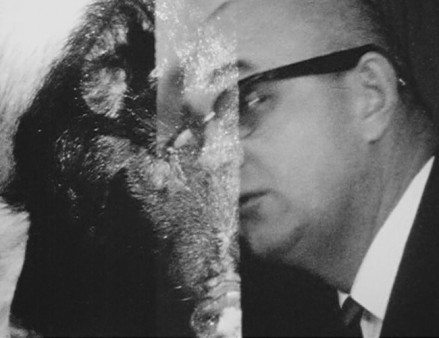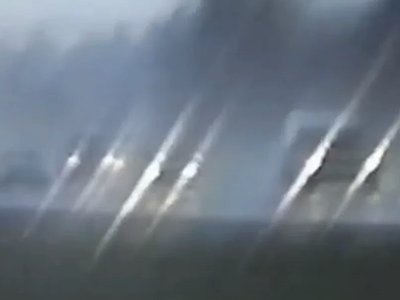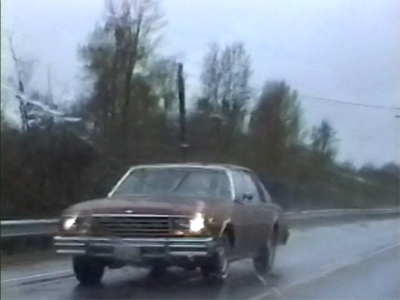Commute
Directed by Bruce Baillie
This review by Paul Arthur was originally published in the Millennium Film Journal issue no. 29 “Video Installation” in 1996.
Not only are we all to some degree Rear Window voyeurs, we are also armchair adventurers. Two of the drives governing film viewing from its historical beginnings are the desire to observe private moments in the lives of people distant from us in one way or another, and the desire to visually traverse distant or unfamiliar settings. While the former, at least in its fictional modality, has elicited entire forests of theoretical speculation, the visual consumption of unknown terrain may turn out to be as primal a marker of the limits of personal identity and self-knowledge. However, unlike the pleasures provided by second-hand intimacy, genre or mode of production are of little import to the framing of spatial otherness; the same scopophilic impulse applies to journeys assayed in documentary, avant-garde, or fiction film discourses. The voyeuristic and-to borrow Tom Gunning’s term for early cinema’s spatial display-the exhibitionistic may of course function in tandem (viz the Road Movie), and although the filmic fantasy of travel may appear bereft of an Oedipal undertow, it almost inevitably acquires an allegorical dimension keyed to prospects for corporeal or spiritual passage.
A fellow pilgrim along the traditional high road of American culture, Bruce Baillie’s greatest work operates under the sign of the nomadic. It is physically transient (in every possible sense), even homeless, constantly yearning for, yet unable to attain a site of stable habitancy, that which accedes to habit. The movement it undertakes, in its false starts and counter-conquests and abnegations, is rarely in a single linear direction but more typically recoils upon itself, either by retracing or muddling a trajectory or by discovering a surprising tangent in an assigned route (think of the sky reversal in All My Life).

And it seems to go with the territory that to adopt the trappings of artistic courier is to identify with all the isolates adrift in our restless society, sharing in their blessings and curses. Hence the summary note in the invocation to Baillie’s short video portrait The P-38 Pilot (1990): “For the dispossessed, the excluded, the condemned, fallen from life and loving.” The drunken, pathetic braggard who forms the subject of this piece-“I’m no fucking bum . . . why do I wind up in the slime pit?”-dominates the soundtrack but appears only fleetingly, if that, masked in a solarized haze of color. As he maunders on about his talents and failed promise, Baillie fills the screen with continuous movements over a field of luscious, nearly abstract shapes and pulsing tints that occasionally bleed into found images (a body builder, marathon runners) or briefly clarify into the desiderata of a cramped domestic interior. Conjured through a screened window, a child’s hand fondles a garden vegetable; later, a bird pecks away at a feeder-the sole indices of a world outside the internalized absorption with self. As debased and repugnant as this guy sounds, Baillie takes the measure of their reciprocal humanity, the implicit continuities and divergences in life paths. An epigraph proclaims that only tolerance and unselfish loving will remove one from eternal isolation. As we consider this, Chet Baker is heard crooning a verse of “There Will Never be Another You.” A tag line completes the pull of memento mori: “Te lucis, ante terminum.”
Commute (1995, videotape, 58 min.), Baillie’s latest tape, “sees the light” from a different angle, and the shadow it casts is more playful, more ironic and literal, but no less infused by the spectre of remembrance. For the better part of a decade, Baillie has been ensconced with his wife Lorie and daughter Wind on an island north of Seattle, mostly unemployed, nearly devoid of cinematic resources and cut off from even the desultory communities of interest that populated his previous way stations. Besides a few scattered videos, he has turned out a series of audiotapes under the imprimatur of “Dr. Bish Remedies,” homemade radio shows specifically designed for “commuters” as a mobile respite from boredom and stress. They consist of a by-now familiar sort of Bishery, rambling monologues in several personae interspersed with bits of music, found messages and other oral entertainments. At first Commute seems nothing more than an “illustrated” version of these radio (non)broadcasts, an hour’s worth of continuous-take rainy Northwest scenery filmed from the passenger seat of a car that may be heading somewhere specific but could just as easily be out for an aimless spin. Whatever else it is, it is clearly post-nomadic, and by the time it is over the tremors sent back into the body of Baillie’s celebrated achievement could rouse even the most sated and saturnine movie motorist.
In an intended tribute to Jack Smith, Bruce starts off in 1930s drag, a chanteuse in lipstick and black sequined dress lip-synching her desire to “share the wild times with you,” and a cut later urging us to “Experiment . . . and it will lead you to the light.” The female impersonation is not unprecedented in Baillie’s work, but in the context of what follows, it recalls, in a caustic inversion, the cowboy-gunslinger figure of Quick Billy’s final act. Once tuned in to the self-referential currents amid this seemingly artless, even childlike presentation, practically every casual item of sound and image becomes ripe for associations with earlier work. Following the direct-address theatrical prelude, a handheld tracking shot departs the house, crosses the lawn, stops to pet the burly dog and piles into the family Honda. For this odyssey even the canine alter ego is left behind. The filmmaker is no longer in the driver’s seat — a feminine hand starts the ignition-and neither the title nor the opening procession augur any hope for the appearance of migrant workers, downtrodden Indians, Bowery bums or any similar icons of the Quixote quest. We are being chaperoned around a flat, commercialized, lower middle-class semi-suburbia; the Frontier has been closed for alterations.
Much as it had been before the onset of domesticity, the car is mobilized as cinematic tool, a rolling studio with its own mixing board-the cassette player into which the radio play is inserted at the start of the trip-screen, and perspectival array. Much of the time the camera is focused on a view of the road through the windshield, but as the ride develops Baillie pans, zooms, and racks focus to include images of the dashboard, out the side window, the side mirror, and the rear mirror. Even more prominent are slow de facto dissolves from the wet surface of the windshield to what lies beyond it. A signature of Baillie’s style from at least Quixote and Valentin de las Sierras, this sinuous exchange between foreground blockage (which itself must be perceived as meaningful image) and figure in the landscape keeps directing the gaze outward and inward by turns.

Even given these shifts of attention, it would be an exaggeration to claim that Baillie transforms this environment into a succession of expressive cues to life’s mysteries. Yet somehow in combination with the audiotape’s historical tidbits and interwoven commentary, a sly philosophical dialogue emerges that embraces the dynamics of still and moving, past and present, presence and absence, isolation and contact. If the “external” world promotes a matching of phonelines against the sky, passing billboards, an ambulance, logging trucks, et al. with the Baillie oeuvre, the dense, often superimposed textures of the “internal” soundtrack creates an historical collage that extends from the 1930s-the period of the filmmaker’s youth-through the vagabond Sixties and into the familial settling of recent years.
As an aural parallel in Quixote to the sliding and colliding visuals, the alternation between different radio stations exemplified the social struggles and cultural diversity of a Sixties’ zeitgeist. Here, a similar technique suggests both an insistent nostalgia and clearheaded review of past thematics. Jack Benny, Welles’s voice as “The Shadow,” the radio intro to “The Lone Ranger,” “Sherlock Holmes,” and Thirties’ dance music might well represent a biographical time of social connection through the radiowaves, in advance of cinema but not entirely separate from it. The advent of Baillie’s audio projects is then not simply a wan substitution, but a return to an essential part of cinema’s roots. Or as Bela Lugosi intones, “For one who has not lived even a single lifetime, you are a wise man, Van Helsing.”


From a slightly later era, Bob and Ray offer a satirical segment in which, as would-be television producers, they are baffled by the fact that no one has watched their recent “Special.” There is a “Movie Quiz” for the listening audience with clips from On the Waterfront, Laurel and Hardy, and others; old friend Paul Tully does a routine from 1964; Robin Williams is caught playing a fundamentalist preacher and Dylan Thomas reads from “Under Milkwood.” Within the ebb and flow of this found material are contributions by Dr. Bish and his assistants and, possibly, “live” conversation between the filmmaker and his daughter (or it may all be on tape). A wonderful interlude involves the attempt to solve a mathematical word problem about cars going from point A to point B to . . .. The effort dissolves in gales of laughter. Commute ends before the trip is completed, on a freeze-frame landscape that becomes a tv monitor in Baillie’s house, which he then signs and copyrights before turning to the camera. Among the vibrant paradoxes sustained by this piece is the fact that in order to see it we must almost certainly be nestled in an armchair in front of our own video machines, not boldly sallying forth in commutation, to say nothing of conquest. And of course Baillie has anticipated this and through gently self-deprecating humor about his own current situation has after all managed to forge a cogent human link between us. His isolation is our pleasure, and vice versa. Far from the brittle artistic sublimity redolent of old age, this work is in the spirit of a wise child at play, eager to entice us with his next ingenious masquerade.
Review by Paul Arthur
Disclaimer: This page is for your personal use only. It is not to be duplicated, shared, published or republished in whole or in part, in any manner or form, without the explicit permission of the publisher, author, and copyright holder(s) of the images.
